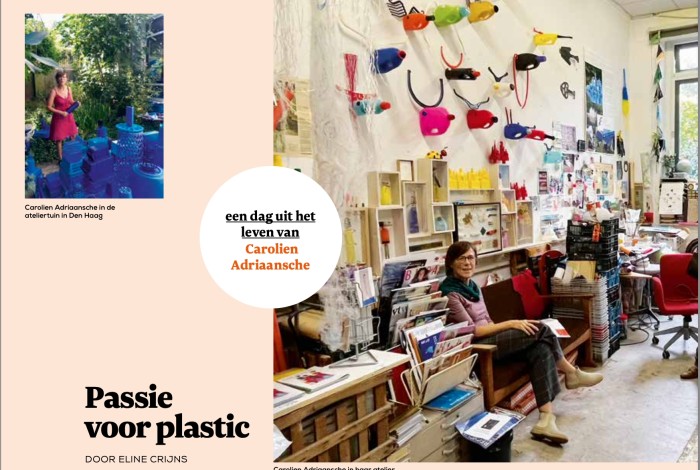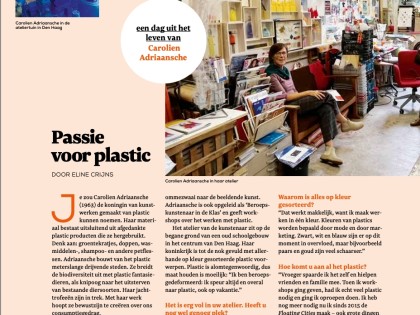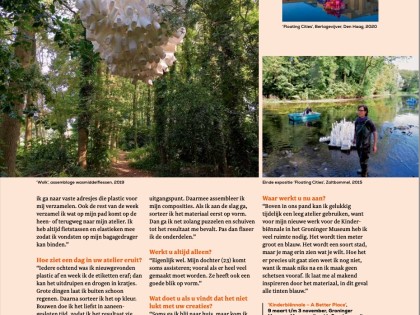Museum Tijdschrift
6 March 2024

Passion for plastic
By: Eline Crijns
Visual artist Carolien Adriaansche (1963) is the queen of artworks made of plastic. Her material consists exclusively of discarded plastic products that she reuses. Think vegetable crates, caps, detergent, shampoo and PET bottles. Adriaansche builds metre-long floating cities from the plastic and expands biodiversity with plastic fantasy animals - her hunting trophies are renowned. With her work, she hopes to create awareness about our consumption behaviour. She works on commission for exhibitions, creates works for specific locations and also corporate gifts. Her work is in high demand; she has the zeitgeist with her. "They used to think when I dipped into containers: that woman is no good," she says.
Adriaansche trained at the Gerrit Rietveld Academy as a theatre designer and began her career as a set designer. A plastic chip fork heralded the turnaround to her work as a visual artist 30 years ago. Adriaansche is also active as a 'Professional Artist in the Classroom' and gives workshops on working with plastic.
The artist's studio sits on the ground floor of an old school building in the centre of The Hague - a place she shares with other creatives from Kunstgreep '95. Her kingdom is filled to the brim with all kinds of plastic objects sorted by colour. Plastic is ubiquitous, so keeping measure is difficult: "I am professionally deformed, plastic sleuthing I do everywhere, even on holiday."
Your studio is very crowded. Do you still have enough space?
"Indeed, I hardly fit in anymore. A cloud of a thousand plastic detergent bottles still hangs in the corridor. Outside in the little garden is a dismantled floating city, whose parts that are still good I incorporate into new works of art."
Why is everything sorted by colour?
"That works easily because I make works from one colour. Colours of plastics are determined by fashion and by marketing. There's a whole world behind that. Black, white and blue is abundant, but, for example, purple and gold are much scarcer."
How do you get all the plastic?
"I used to save it myself and friends and family helped out. When I started giving workshops, I really needed a lot of plastic and started making calls and looking for it in a targeted way. I need even more since I started making the 'Floating Cities' in 2015 - including big things like crates and barrels for buoyancy."
You also scour places yourself?
"Monday afternoon is transport afternoon, which is when I go out by car. Due to lack of space, I try to find only what I need for the projects I am working on. At the market, I get plastic fruit and vegetable crates and I go to regular addresses that collect plastic for me. Also during the rest of the week, I collect whatever comes my way on the way to or back from my studio. I have panniers and rubber bands to tie finds onto my luggage rack if necessary."
What does a day in your studio look like?
"First thing in the morning, I wash plastic that has come in new and soak off the labels; then it can drain and dry in crates. Big things I let it rain clean outside. Then I sort it by colour. I prefer to build in continuous time, so that I can see results. I don't take breaks, except sometimes having lunch in the garden with fellow artists from the building. All the computer work I do at home."
How do you assemble the plastic together?
"With tie-wraps in the same colour or with glue. I will never cut or carve into objects; the existing shape is the starting point. With that, I assemble my compositions. When I get started, I first sort the material by shape. Then I keep puzzling and shifting until I like the result. Only then do I fix the parts."
Do you always work alone?
"Actually, yes. My daughter (23) sometimes comes to assist; especially when a lot has to be made. She also has a good eye for form."
What do you do when you find that your creations don't work out?
"Sometimes I go home happy and come in the next day and think: it's not good at all. Then I ask a colleague on the premises to look at it with fresh eyes. Often that helps."
What are you working on now?
"Upstairs in our building I can fortunately use an empty studio temporarily, because I need a lot of space for my new work for the Children's Biennial at the Groninger Museum. It will be ten metres and is blue. Sort of like a city, but you can see what you want in it. How exactly it will look I don't know yet, because I don't copy anything and I don't make designs in advance. I get inspired by the material, in this case all shades of blue."
Children's Biennial - Groninger Museum - 9 March to 3 November 2024 - groningermuseum.nl - carolienadriaansche.nl


